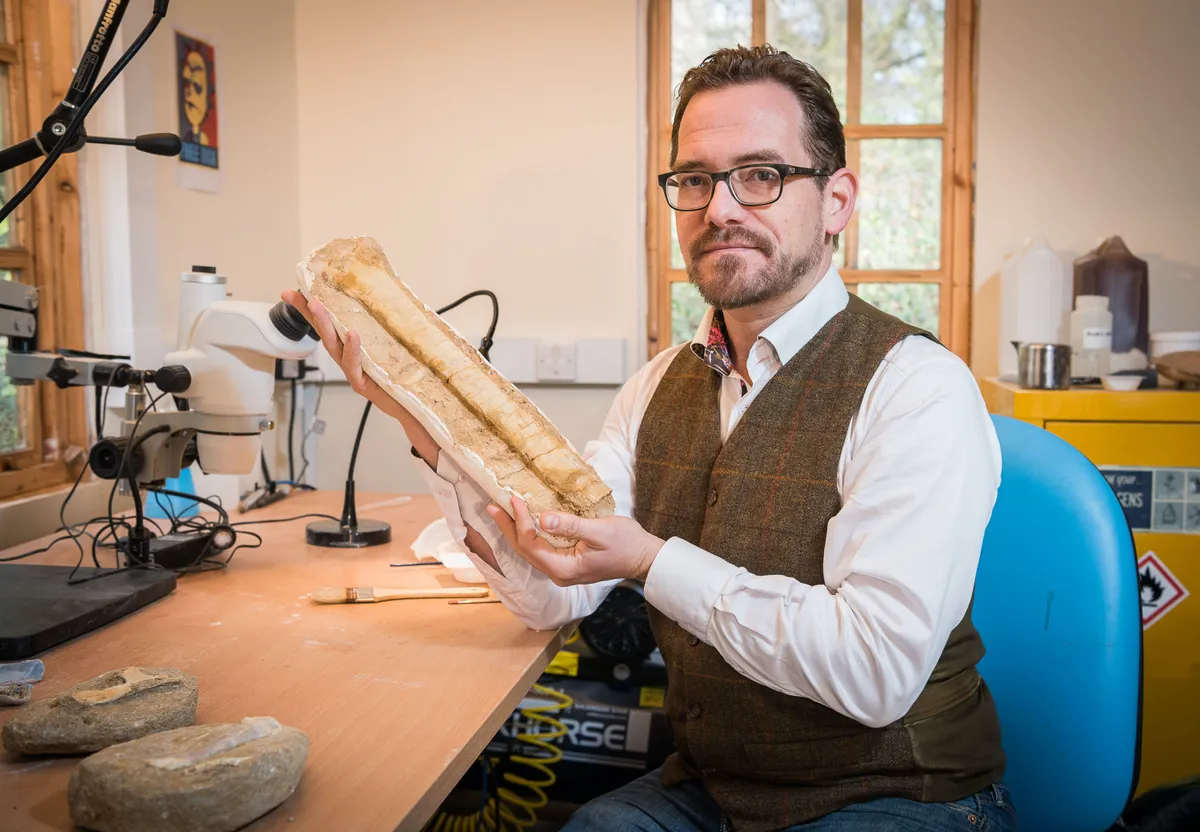The first fossils of a duckbilled dinosaur have been discovered in Africa, suggesting that dinosaurs crossed oceans to get there.
Researchers discovered the fossils of the new dinosaur, Ajnabia odysseus, in rocks in Morocco dating to the end of the Cretaceous period, 66 million years ago.
Ajnabia was a member of the duckbill dinosaur group – diverse plant-eating reptiles that grew to up to 49ft (15m) long – and was only about 10ft (3m) long.
Duckbills evolved in North America and eventually spread to South America, Asia and Europe.
Africa was an island continent in the Late Cretaceous period and isolated by deep sea, so it had seemed impossible for duckbill dinosaurs to get there.
Read more about dinosaurs:
- 200 million-year-old fossil shows dinosaur ‘walked like a guineafowl’
- Fossilised dinosaur skull reveals adorable appearance of baby sauropods
Dr Nicholas Longrich, of the Milner Centre for Evolution at the University of Bath, said discovering the new fossil in a mine a few hours from Casablanca was “about the last thing in the world you would expect”.
“It was completely out of place, like finding a kangaroo in Scotland. Africa was completely isolated by water – so how did they get there?” Dr Longrich said.
“Sherlock Holmes said, once you eliminate the impossible, whatever remains, no matter how improbable, must be the truth.
“It was impossible to walk to Africa. These dinosaurs evolved long after continental drift split the continents, and we have no evidence of land bridges.
“The geology tells us Africa was isolated by oceans. If so, the only way to get there is by water.”

Scientists examined Ajnabia’s distinctive teeth and jawbones and found that the dinosaur belonged to Lambeosaurinae, a subfamily of duckbills with elaborate bony head crests.
Lambeosaurs evolved in North America before spreading to Asia and Europe and have never been discovered in Africa before.
The duckbills must have crossed hundreds of miles of open water, either rafting on debris, floating or swimming, to reach Africa.
They were probably powerful swimmers, as they had large tails and powerful legs, and are often discovered in river deposits and marine rocks so may have swum the distance.
Read more about dinosaurs:
- What did dinosaurs evolve from?
- Dinosaur discovered on the Isle of Wight a relative ofT. rex
- Dinosaurs’ flying relatives could hold key to building better drones
In reference to this, the dinosaur is named Ajnabia odysseus – Ajnabi is Arabic for “foreigner” and Odysseus comes from the Greek seafarer.
Ocean crossings involving animals are rare events but have been previously observed.
In one case, green iguanas used debris to travel between Caribbean islands during a hurricane.
A tortoise from the Seychelles also floated hundreds of miles across the Indian Ocean to wash up in Africa.
“Over millions of years, once-in-a-century events are likely to happen many times,” Dr Longrich said.
“Ocean crossings are needed to explain how lemurs and hippos got to Madagascar, or how monkeys and rodents crossed from Africa to South America. As far as I know, we’re the first to suggest ocean crossings for dinosaurs.”
The international team of scientists was led by the University of Bath, with researchers from the University of the Basque Country UVP/EHU in Spain, George Washington University in the US, the Natural History Museum of Sorbonne University in France, and Universite Cadi Ayyad in Morocco.
Dr Nour-Eddine Jalil, from the Natural History Museum of Sorbonne University, described how the dinosaurs reached Africa, and finding the fossil of a terrestrial animal in a marine environment as a “succession of improbable events”.
This “highlights the rarity of our find and therefore its importance”, Dr Jalil said.
“Ajnabia shows us that hadrosaurs have set foot on African land, telling us that ocean barriers are not always an insurmountable obstacle.”
Reader Q&A: Would the dinosaurs have eaten us if we were alive at the same time?
Asked by Sarah Deery
Let’s imagine humans living 66 million years ago, alongside the biggest meat-eating dinosaur of all,Tyrannosaurus rex.T. rexsurely would have been able to eat people. There are fossil bite marks, matching the teeth ofT. rex, on the bones ofTriceratopsand duck-billed dinosaurs such asEdmontosaurus, which were both over 50 times heavier than an average person. But that doesn’t mean we would be hunted to extinction.
Like the prey of lions and tigers today, we would have been in danger, but found ways to survive. Many dinosaurs that were smaller than us survived alongsideT. rex, and none of them had the benefit of our large brains!
Read more:
